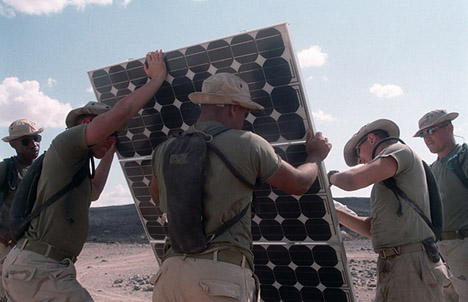Staying on the military-meets-renewable-energy theme that my colleague Mike touched on, I felt compelled to offer a quick, if rather frustrating, update on a post I did at the end of last year. That post looked at the US Navy’s plans to deploy a “green fleet” in the Pacific this summer; green in the sense that it would be powered by a 50-50 blend of fossil and biofuel.
 To fuel the green fleet’s cruise, the Navy contracted with a company out of Baton Rouge, Louisiana, and broke out the checkbook to pay a per-gallon biodiesel price substantially above the price for fossil-based diesel. At the time I wrote of this arrangement:
To fuel the green fleet’s cruise, the Navy contracted with a company out of Baton Rouge, Louisiana, and broke out the checkbook to pay a per-gallon biodiesel price substantially above the price for fossil-based diesel. At the time I wrote of this arrangement:
And progress often comes at a price above the going market rate. So thank goodness the Navy understands the threat that reliance on a finite vital resource represents to its way of life (and/or death) and is willing to pay those higher prices as an investment in companies that demonstrate they might have a promising solution.
So the Navy gets it. Congress? Sadly, no. According to recent reports, the House Armed Services Committee, chaired by Howard “Buck” McKeon (R-California), is leading the charge on legislation that would prohibit the Pentagon from purchasing alternative fuels or building their own facilities to create them “if the cost exceeds the cost of traditional fossil fuels used for the same purpose.” Meanwhile over in the Senate, a former Navy airman weighed in to support Buck’s stoppage:
“It’s a job for the Department of Energy, not the Department of Navy,” Sen. John McCain (R-Ariz.), the ranking member of the Senate Armed Services Committee, said in an interview. “You shouldn’t be paying $244 per gallon when we are having to retire ships early.”
Of course, efforts by the DOE to push renewables and alternatives haven’t met a warm pachyderm embrace. Fossil fuel is finite. Their cost curve, barring complete global economic meltdown, only points up. Alternatives will be needed.
The US military spends a lot of time war gaming future scenarios and positioning for those most likely to develop. The investment it’s been making in efficiency and alternative energies could rightly be read as a positioning exercise. The move by green opponents in Congress could be seen as a depositioning exercise – for the country.
